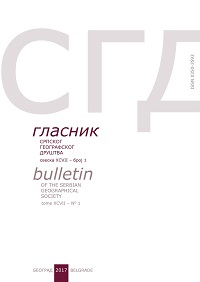Демографски раст и развој бањских места у Србији
Demographic growth and development of spa places in Serbia
Author(s): Branislav S. Đurđev, Kristina T. Košić, Aleksandra S. DraginSubject(s): Health and medicine and law, Demography and human biology, Tourism
Published by: Српско географско друштво
Keywords: Serbia; spas; demographic transitions;
Summary/Abstract: The paper deals with analysis of population growth and components of demographic growth in five most important spa settlements in Serbia: Vrnjacka banja, Niska banj, Banja Koviljaca. As indices of demographic development, we have analysied: natural and mechanical movement of population, age and sex, activity and sex, households and apartments in spa places. The finding is that demographic development of spa places in Serbia has been politically influenced. Due to dismantling state teritory of former Yugoslavia, the choice of domestic tourist destination for Serbian population became smaller. Because of that, spas became more important tourist destination which fostered demographic growth of those places. The data analysis demonstrated that during the last six decades, population in all spa places increased with higher intensitive compare with the rest of Serbia. This is the result of high inmigration, particulartly in the last decade, when the share of this movement was over 90%. The pacing of population ageing in spa places, did not follow ageing of total population in Serbia. Average age in Serbia between 1961-2002. increased for 31.8%, while in spas population ageing was more intensify with 36.4% increase. The number of household showed constant increase from census to census, as well as in Serbia as in each of spa plasec with no exception. Average size of household in spas in 1948. was smaller than the average in Serbia for almost one member. By the year 2002. the average sizes of households in spas and in Serbia was almost equalized. Spa places suffered sortage of apartments in 1948. By the year 2002. the evidence showed considerable surplus which as the biggest in Vrnjacka Banja spa. The amount of surplus was 15%, which is higher than the average in Serbia. The purpose of this surplus is rent and accomodation of spa visitors. Overall results point out that despite of population decrease of Serbia, spa places enjoy more and more permanent residents. Among the reasons economic stability of spa places (in the areas of services and medical care) should be emphasized, which triggered inmigration increase, outmigration decrease, and slawer rate of ageing (despite of small rate of natural increase).
Journal: Гласник Српског географског друштва
- Issue Year: 87/2007
- Issue No: 1
- Page Range: 69-78
- Page Count: 10
- Language: Serbian

